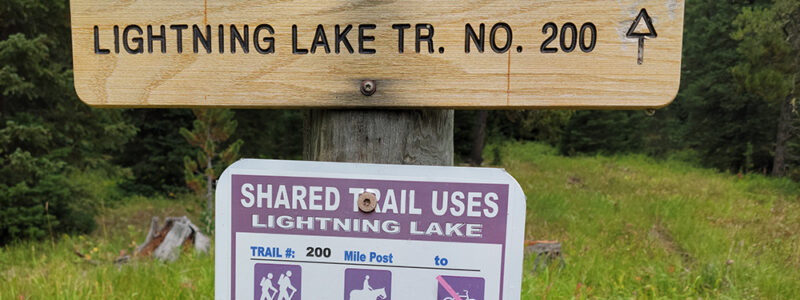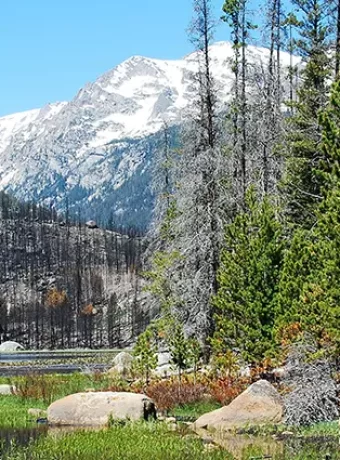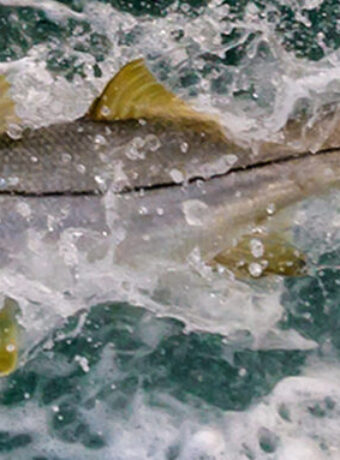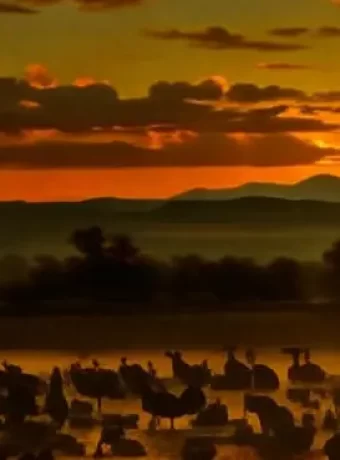Day Hike to Lightning Lake Trail: A Trail Guide
Have you ever felt that itch for an adventure, but maybe not one that leaves you breathless from exhaustion? I totally get it. Sometimes you just want beautiful views without an extreme challenge. That’s where an excellent Day Hike to Lightning Lake Montana comes into play, offering just the right mix of ease and splendor.
Picture this: a trail that guides you through whispering forests, across sun-drenched meadows, and finally to a sparkling lake. All of this natural beauty is found within the stunning Lee Metcalf Wilderness. This journey is not about pushing your limits; it is about soaking in Montana’s wild beauty, making a Day Hike to Lightning Lake Montana potentially your perfect escape. As soon as we crossed into the wilderness a pretty good size Black Bear greeted us.
Table of Contents
A Hike in Yellowstone’s Greater Ecosystem
Lightning Lake is four point one miles in from the trail head. Trail is what I consider to very moderate, only the distance in my mind turns it into an intermediate hike. Elevation gain to the lake is only thirteen hundred feet, with on short section of some switch backs. Trail wanders through several meadows with a beautiful ridge to the west and you cross Beaver Creek several times to leaving behind to the east. Just after entering the Lee Metcalf Wilderness about half mile from Lightning Lake a three hundred plus Black Bear stepped on the trail. Black Bear was thirty yards in front of us. Didn’t even know we were there till I yelled at. Bear scrabble off through the Gallatin National Forest.
This is a nice hike with great destinations for the thru hiker in you. Or you could end up in a Montana Petrified Forest or backpack through Yellowstone National Park. Learn more about the Greater Yellowstone Ecosystem.
Lightning Lake Trail Head, West Yellowstone, Montana

Sun Protective Wolf Graphic Hoodie
Hiking to Lightning Lake good outdoor apparel creates comfort from the elements. Our Timber Wolf Graphic Hoodie is a UPF-50 Sun Protection with a sewn in facemask and thumb hole cuffs.
Explore Montana with a Central Montana Vacation Rental. Mountain biking, wildlife, and fly fishing.
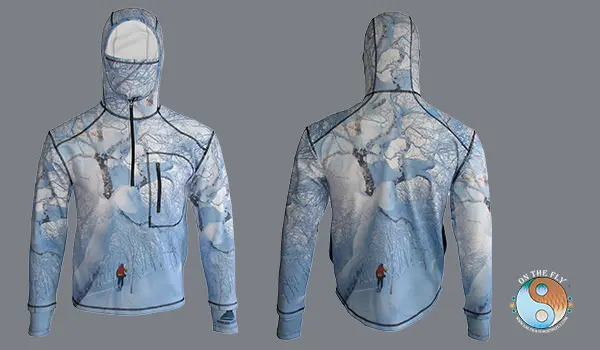
What to Expect on Your Lightning Lake Hike
So, you are thinking about this hike? That is a good choice for a memorable day. The Lightning Lake trail is a pleasant out-and-back journey, well-suited for most fitness levels. It covers about 8.2 miles round trip, meaning you will walk 4.1 miles to reach the lake itself and the same distance back.
The climb is gentle, gaining around 1,300 feet in elevation over the course of the hike. This makes it mostly easy, with just a touch of moderate difficulty attributed mainly to the total distance rather than any particularly steep sections. Most hikers complete the round trip in 4 to 6 hours, allowing for a relaxed pace and time to enjoy the destination, with a picnic lunch as we did. Just us the jays and a couple of does.
The trail surface is primarily packed dirt, though you will encounter some tree roots and rocky patches that require attention. It is generally well-maintained during the main hiking season, which typically runs from late June through September. Early season hikes might involve some snow patches or muddy spots, while late season can bring cooler temperatures and even early snow.
| Aspect | Details |
|---|---|
| Total Distance | 8.2 miles (round trip) |
| Distance to Lake | 4.1 miles (one way) |
| Elevation Gain | Approximately 1,300 feet |
| Difficulty Level | Easy to Moderate |
| Trail Type | Out-and-back |
| Typical Hiking Time | 4-6 hours |
| Best Seasons | Late June to September |
| Key Highlights | Old-growth forest, expansive meadows, gentle creek crossings, stunning Lightning Lake, Lee Metcalf Wilderness Area access. |
You will discover that this trail does not rush you. Its mellow grade lets you enjoy the journey, from the shade of old trees to the open sky of the meadows. You will also cross a few small creeks, but these are usually simple enough to manage, adding a bit of fun to the trek; waterproof footwear can be beneficial here.
And the reward at the end? Lightning Lake itself is a sight you will not soon forget, offering serene beauty. Keep an eye out for wildlife such as deer, elk, marmots, pikas, and various bird species along the way. While less common on a busy day trail, black bears and grizzly bears inhabit this region, so awareness is important.
Finding Your Way: Getting to the Trailhead
Reaching the starting point for your Lightning Lake adventure is fairly simple. You do not need to be a map expert for this one. The trail begins at Potamogeton Park, located off Beaver Creek Road (Forest Service Road 985) near US-287. It is a known spot for hikers looking for accessible trails near West Yellowstone.
If you are coming from West Yellowstone, Montana, here is the route: Drive north on US-287 for about 20 miles. Look carefully for the sign for Beaver Creek Road on your right; it is not large or flashy. Once you turn onto Beaver Creek Road, you will follow this gravel road for another 4.5 miles.
Beaver Creek Road can be a bit bumpy and rutted in places, particularly after rain or during snowmelt. While high-clearance vehicles are not always necessary, drivers of low-slung cars should proceed with caution and take their time. Arrive early, especially on summer weekends, as the parking area at Potamogeton Park can fill up. There is a pit toilet available at the trailhead, a welcome facility before starting your hike.
One important tip: You should check current Forest Service road conditions before you head out, especially if it is early spring or late fall. Unexpected snow, fallen trees, or mud can make Beaver Creek Road tricky or impassable. Starting your hike with car trouble is no fun, and cell service is unreliable in this area, so plan accordingly by downloading offline maps and trail information.
The town of West Yellowstone is your last main stop for gas, groceries, and any last-minute hiking supplies. Fill up your water bottles there, or be prepared to filter water on the trail if you are experienced in doing so from reliable sources.
Greater Yellowstone Ecosystem Adventures Await
Live the adventure of a life time. Learn entomology of a spring creek, or how to become a better at casting from tournament casting instructors. Learn how to tie flies to fish spring creeks and read the water. Or if that’s not your fancy go with a guide on a Livingston, Montana spring creek, a day on the Yellowstone River or book a few days on the Kootenai River. At Get Lost in America we have you covered with a team that has over 200 years of experience in the field. Learn more about Montana’s National Forest, Rivers, and Trails Click Here.
The Journey to Lightning Lake: A Step-by-Step Guide to Your Day Hike to Lightning Lake Montana
Alright, boots on and ready to go? The trail to Lightning Lake is generally well-marked and easy to follow. However, it is always nice to know what is coming up. So, here is a little walkthrough of your trek to that beautiful alpine lake.
First Steps: Through the Old Forest
The adventure starts with a peaceful walk through an old forest, filled with the scent of pine and damp earth. You will be surrounded by tall, slender lodgepole pines, which create a wonderful, shaded canopy on sunny days. You will also spot Douglas firs and Engelmann spruces adding some variety to the woods, their needles carpeting the forest floor in places.
The path underfoot is mostly smooth, with just a few roots and rocks here and there. These features keep things interesting but are not too challenging for most hikers. Listen for the sounds of the forest: the chatter of squirrels, the rustle of leaves, and the distant tapping of a woodpecker.
Soon, you will come across the first of several crossings over Beaver Creek. These are not major obstacles, usually consisting of easy steps on well-placed rocks or a shallow wade during lower water periods. Using trekking poles can aid balance during these crossings. Wearing waterproof shoes is a good plan, or at least having quick-drying ones and perhaps an extra pair of socks.
As you wander through this forest, keep your senses alert for wildlife. You might see deer moving gracefully between the trees. Bears also live in this area, so it is good to be aware and practice bear safety by making noise, carrying bear spray, and knowing how to use it. Spotting one from a safe distance can be thrilling, but remember that wildlife is wild and should be given plenty of space.
Into the Sunshine: Exploring the Meadows
After about a mile or so, the dense forest begins to thin out. You will step into wide, open meadows where sunlight bathes the landscape. It feels like the trees decided to part ways and let the sunshine pour in. The change in scenery is quite refreshing and offers expansive views.
The native grasses stretch far, often dotted with colorful wildflowers depending on the season. You might see bright yellow arrowleaf balsamroot in early summer, purple lupines, vibrant red Indian paintbrushes, or even the delicate glacier lily if your timing is right. Later in the summer, asters and goldenrod add their hues. Bees and butterflies are often busy among these blooms.
The views expand here too. Rugged mountain peaks, possibly with lingering snowfields early in the season, frame the horizon, making for some splendid photo opportunities. This is a perfect spot to pause, take a few deep breaths of clean mountain air, and maybe even enjoy a small snack while admiring the scenery. The trail continues its gentle ascent through these meadows, a steady climb but nothing too strenuous.
These meadows are also great places to look for wildlife. Elk and deer are frequently seen grazing peacefully here, especially in the cooler parts of the day. And yes, it is still possible to encounter bears foraging in these open areas. So, being mindful of your surroundings remains important; scan ahead frequently and make your presence known.
Deeper into Nature: Entering Lee Metcalf Wilderness Area
As you get closer to the lake, roughly half a mile before you reach it, you will cross an important boundary. You officially enter the Lee Metcalf Wilderness Area. This area is a specially protected piece of Montana, part of the National Wilderness Preservation System. It is named after former Montana Congressman Lee Metcalf, who deeply cared about saving wild places for future generations. As we crossed that imagery line into the wilderness area a large black bear stepped out on the trail. It was about 40 yards out, stood and starred for a moment and wandered on. Make sure you have your bear spray handy and not in your pack.
Being in a designated wilderness area feels special. It means the land is managed to be kept as natural and untrammeled by humans as possible. This is where Leave No Trace principles become even more vital. Stick to the marked trail, pack out everything you brought in (including food scraps and toilet paper), and help keep this place beautiful for everyone.
The scenery seems to get even more dramatic as you approach Lightning Lake. The trail makes a few short switchbacks here, gaining elevation a bit more noticeably. This is probably the steepest part of the entire hike, but it is very manageable and does not last long. You might pass by a large granite rock formation on your left, a testament to the area’s geological history and a good spot for another quick photo.
A sense of remoteness and solitude may increase as you travel deeper. Then, just as you are wondering how much farther, you will come over a small rise. And there it is – Lightning Lake, waiting for you in all its serene glory.
Lightning Lake: Your Serene Destination
Reaching Lightning Lake is truly rewarding. It is the kind of view that makes any tired legs feel instantly better. The lake sits nestled among towering peaks, with thick subalpine fir and Engelmann spruce forests surrounding its shores. Its water is often crystal clear, reflecting the sky and mountains like a perfect mirror on calm days.
It is incredibly peaceful here, a place to escape the noise of daily life. You will find plenty of flat rocks and grassy spots along the shoreline. These are perfect for spreading out a picnic, taking a well-deserved nap in the sun, or just sitting and soaking it all in. Listen to the gentle lapping of water or the call of a Clark’s Nutcracker.
If you are feeling adventurous, a quick dip in the lake can be very invigorating. Be warned, the water is mountain-cold, the kind that wakes you up fast even on a warm day. For those who enjoy fishing, Lightning Lake is known to hold trout, possibly cutthroat or brook trout; a Montana fishing license is required. Otherwise, simply enjoy your lunch and the serene beauty around you. It is a place where you can easily forget about the everyday hustle and just be present in nature.
Take some time to explore the lake’s edge, but watch your step on any rocks near the water, as they can be surprisingly slippery. Consider the best angles for photography; morning and late afternoon light often provide the most dramatic results. Remember to allow ample time for your return hike, especially if afternoon thunderstorms are a possibility.
Smart Hiking: Tips for a Great Lightning Lake Trip
To make your Day Hike to Lightning Lake Montana as enjoyable and smooth as possible, a little preparation goes a long way. Here is some friendly advice gathered from experience in the backcountry.
- Hydration and Nourishment: Always pack enough water; at least two liters per person is a good starting point, more on hot days. Alternatively, bring a water filter or purification tablets to treat water from Beaver Creek (check current conditions and best practices for sourcing). Pack high-energy snacks like trail mix, energy bars, nuts, seeds, dried fruit, jerky, and a satisfying lunch. Remember to pack out all food scraps, including peels and cores.
- Appropriate Footwear: Sturdy, broken-in hiking boots that offer good ankle support and have decent tread are your best friends on this trail. They are especially helpful for the creek crossings and any rocky or root-filled sections. Waterproof boots are a definite plus; if yours are not waterproof, consider bringing an extra pair of dry socks.
- Navigation Tools: While the Lightning Lake trail is usually clear and well-signed, carrying a map of the area and a compass (and knowing how to use them) is always prudent. A charged phone with a reliable GPS app and downloaded offline maps for the region is a great tool. Conserve your phone’s battery by putting it in airplane mode when not actively using GPS. Always tell someone your hiking plans and expected return time.
- Weather Preparedness: Mountain weather can change very quickly. Check the forecast before you leave, but be prepared for shifts. The lake is named Lightning Lake for a reason; afternoon thunderstorms can develop, especially in summer. Dress in layers (base wicking layer, insulating mid-layer, waterproof and windproof outer shell) so you can adjust to changing conditions. Do not forget sun protection: a wide-brimmed hat, sunglasses, and sunscreen are important even on cloudy days.
- Insect Management: Mosquitoes, biting flies, and other insects can be present, particularly near water sources and in wooded areas during warmer months. A good insect repellent containing DEET or Picaridin can make your hike much more comfortable. Wearing long sleeves and pants can also offer protection. Perform a tick check after your hike.
- Leave No Trace Principles: Practice Leave No Trace ethics to help preserve the beauty and health of the wilderness. This includes packing out all your trash, staying on marked trails to protect fragile vegetation, observing wildlife from a distance, and being considerate of other hikers. If you must go to the bathroom, do so at least 200 feet from water sources and trails, and pack out toilet paper.
- Wildlife Safety: Be bear aware. Make noise while hiking (talking, singing, or using a bear bell) to avoid surprising a bear. Carry bear spray and know how to deploy it quickly and effectively; keep it accessible on your hip or chest strap, not buried in your pack. If you encounter a bear, do not run; stand your ground, speak calmly, and slowly back away. Store food securely even during daytime stops. Moose can also be encountered and can be aggressive, especially with calves; give them a very wide berth.
- First-Aid Kit: Carry a well-stocked first-aid kit with essentials like adhesive bandages of various sizes, antiseptic wipes, gauze pads, medical tape, pain relievers, blister treatment (moleskin or similar), and any personal medications. Knowing basic first aid can be invaluable.
- Communication: Cell service is highly unlikely on the trail and at the trailhead. For added safety on more remote hikes, consider carrying a satellite messenger or personal locator beacon (PLB) for emergencies.
Starting your hike early in the day is another good tip. This helps you beat potential afternoon heat, especially in July and August, and reduces the risk of being caught in an afternoon thunderstorm. You will also likely find better parking at the trailhead and have more time to relax and enjoy the lake without feeling rushed.
A Glimpse into the Past: The Story Behind the Name
Lightning Lake did not get its name by accident. This area, like many high-elevation spots in the Rocky Mountains, is prone to summer thunderstorms. These storms can build quickly, bringing dramatic lightning displays and sudden downpours. If you hear thunder rumbling or see dark clouds gathering, it is a signal to be mindful of your location and avoid exposed areas like ridgetops, open meadows, or being on the water. Seek lower ground or a dense stand of smaller trees if caught out.
The lake itself is a product of ancient glaciers. Thousands of years ago, massive sheets of ice carved out the landscape of the Taylor Hilgard Mountains, grinding down rock and sculpting valleys. These glaciers left behind depressions, known as cirques, which eventually filled with meltwater to form beautiful alpine lakes like Lightning Lake. You can almost feel that immense geological history and power when you are standing by its shores, surrounded by glacially carved peaks made of resilient metamorphic and granitic rocks.
The Lee Metcalf Wilderness Area, which you hike into, was established in 1983. It honors former Montana Congressman Lee Metcalf, a Kalispell native and a strong advocate for conservation and protecting America’s wildlands. He played a significant role in the passage of the Wilderness Act of 1964 and championed the preservation of many Montana landscapes.
This wilderness spans over 248,000 acres and is divided into four separate units. Lightning Lake is located in the Taylor-Hilgard unit, the largest of the four. This section is particularly known for its rugged peaks, numerous high-country lakes, and its importance as wildlife habitat within the Greater Yellowstone Ecosystem. So, when you hike here, you are not just enjoying a pretty walk; you are also experiencing a landscape preserved thanks to foresight and a commitment to conservation, a legacy of people like Lee Metcalf.
Conclusion of Lightning Lake Trail
As you make your way back from Lightning Lake, take a moment to enjoy the changing light in the meadows and the quiet of the forest once more. Hopefully, any wildlife encounters are pleasant and from a respectful distance. The Day Hike to Lightning Lake Montana truly is a special destination, offering an experience that revitalizes the spirit.
It is accessible enough for a relaxing day outdoors for many people, yet it offers the kind of stunning scenery that makes you feel like you have stepped into a postcard from Big Sky Country. It is a perfect blend of gentle challenge and profound natural beauty. This hike provides a wonderful taste of the Montana backcountry without requiring an overnight commitment or extreme exertion.
So, if you are looking for an easy yet incredibly rewarding hike near West Yellowstone, this should be high on your list. Get your boots ready, pack some tasty snacks and essential gear, and go experience the magic of Lightning Lake for yourself. You will likely come back with great memories, some fantastic photos, and a deeper appreciation for Montana’s wild places.
